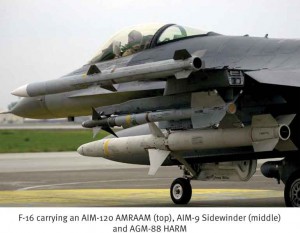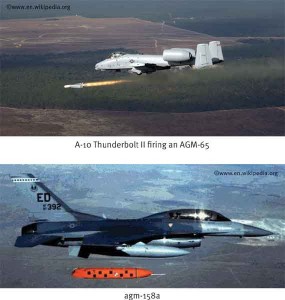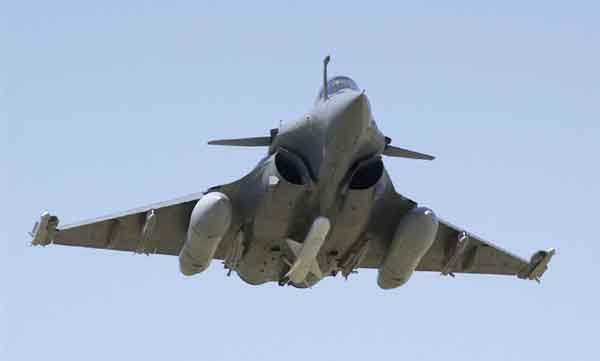The collateral damage in the drone attacks in Afghanistan and Pakistan are a constant reminder that the use of precision air-to-ground weapons is still beset with problems. Results have shown that even in an area where there is complete dominance of the air space and no threat from ground-based surface-to-air missiles, the use of precision weapons can cause serious collateral damage.
The Fulda Gap, a region between the former East German border and Frankfurt was strategically important during the Cold War as a possible route for the Warsaw Pact armour to break out in the event of war in Europe. A whole range of aircraft and weapon systems were developed by the West to counter this possible armour offensive and to minimise the threat to NATO aircraft from the formidable integrated air defence system of the Warsaw Pact forces. I Both the West and the erstwhile USSR developed aircraft and weapons to enhance offensive capability and reduce vulnerability of their own forces. Although this combat scenario was never tested, it provided the technological impetus for the development of sophisticated air launched Precision Guided Munitions (PGM).
In the aftermath of Desert Storm much of the limitation of the field of vision (FOV) of advanced targeting systems and sensors, insufficient resolution for target discrimination at medium and high altitude and vulnerability to weather have all been addressed, but still remain critical to weapon effectiveness.
The Falkland War of 1982 saw the effect of air-to-surface missiles when an Argentine Navy Super Entendard fired an Exocet AM-39 missile and disabled the HMS Sheffield. Similar weapons were used during the Iran-Iraq War (1980-88). Operation Desert Storm in January-February 1991, the first time since the Vietnam War when air power was employed on a massive scale, marked the beginning of the era of sophisticated air operations.. The air campaign saw the deployment by coalition forces of nearly every type of fixed wing aircraft and helicopter. The American forces alone flew over 40,000 strike and 50,000 support missions. The Operation provided an opportunity to assess the operational performance of a large number of combat aircraft and weapons systems under actual combat conditions. Operational tests under controlled conditions or small scale skirmishes do not provide adequate data to provide long term projections of aircraft and weapon capabilities. The US General Accounting Office (GAO) conducted a study on the operations with the following objectives :
- Determine the use, performance and effectiveness of weapons systems and to establish the co-relation between the actual performance in war and claims of the manufacturers.
- Describe the relationship between cost and performance of the weapon employed.
- Establish whether the unique conditions in Iraq limit the lessons learnt. CNN’s spectacular footage of PGMs destroying bridges and tanks conveyed the impression that these munitions provided a panacea for air-to-ground operations but the GAO report found otherwise. The report was classified but the summary laid the guidelines for the development of future weapons particularly air-to-ground weapons. GAO’s analysis of the results of the bombing showed :
- The effectiveness of air power was inhibited by the aircraft sensor’s inherent limitations in identifying and acquiring targets.
- There were failures to gather intelligence on the existence or location of certain critical targets. The ability to collect and disseminate timely battle damage assessments was found wanting .
- Pilots noted that infra-red, electro-optical and laser systems were seriously degraded by clouds, rain, fog, smoke and high humidity.
- The reduced accuracies of weapons released at medium and high altitude and absence of timely Battle Damage Assessment (BDA) led to reduced effectiveness, increased risks from making repeat strikes and overall increased cost.
- “One Bomb One Target” efficiency was not achieved.
The air campaign did not validate the purported efficiency of precision munitions and in many cases, the manufacturers claims about weapons system performance were overstated, misleading, inconsistent with the best available data or unverifiable. In the aftermath of Desert Storm much of the limitation of the field of vision (FOV) of advanced targeting systems and sensors, insufficient resolution for target discrimination at medium and high altitude and vulnerability to weather have all been addressed, but still remain critical to weapon effectiveness. Designs and technology are constantly tweaked to ensure that the limitations of one aspect of the weapon is offset by the advantages of another on-board subsystem.
The next major air operations was against the Bosnian Serb Army (BSA) in August-September 1995 which saw the NATO forces launch Operation Deliberate Force attacking :
- Key air defence communication nodes.
- Air Defence Command and Control facilities.
- Early Warning Radar sites.
- Known Surface to Air missiles (SAM) sites.
- SAM support sites.
- Infrastructure and lines of communications.
All these targets were engaged with a preponderance of precision munitions. The NATO and US forces flew 3515 missions but more importantly, as against 318 dumb bombs, 708 precision munitions were used. The objectives of the air war were achieved but there were 317 civilian casualties to aerial attacks.
In 1999 NATO conducted Operation Allied Force over Kosovo for 78 days committing over than 900 aircraft to the operation…Despite the use of precision munitions there were about 500 civilian casualties in 90 incidents.
In 1999 NATO conducted Operation Allied Force over Kosovo for 78 days committing over than 900 aircraft to the operation. More than 37,000 sorties were flown of which, 14,000 were strike missions and it is reported that over 37 per cent of the 23,000 bombs and missiles launched were precision munitions. Despite the use of precision munitions there were about 500 civilian casualties in 90 incidents. The collateral damage in the air war against targets in an urban environment produced some of the worst Public Relations disasters which included attacks on a civilian radio and TV station in Belgrade and the Chinese Embassy.
The collateral damage in the drone attacks in Afghanistan and Pakistan are a constant reminder that the use of precision air-to-ground weapons is still beset with problems. Results have shown that even in an area where there is complete dominance of the air space and no threat from ground-based surface-to-air missiles, the use of precision weapons can cause serious collateral damage. Air operations by NATO in the recent past in support of rebel forces in Libya has shown that air power can be decisive. It allowed the dissidents to advance under cover of an air umbrella and bring the fight to Col Qaddafi’s headquarters in Tripoli. Air operations in Yugoslavia, Afghanistan and Libya reiterate the lessons learnt earlier and drive home the point that :
- Multi sensor capability is essential to give the weapon an all weather capability. Smoke, bad weather and dust obscured targets in Kosovo and Bosnia preventing attack by laser guided bombs.
- Larger stand-off distances for the launch aircraft give it a much higher degree of protection from air defence systems.
- The high cost of air to ground missiles and other guided munitions need to be addressed and made more affordable while considering weapon-target matching
- Accurate low explosive yield weapons are essential to reduce collateral damage
- Battle Damage Assessment systems are central to establish the efficacy of the mission and can avoid wasteful re-targeting of the same target.
- Air Forces prefer to use precision weapons to dumb bombs as this can reduce the number of missions required to destroy a target
The JAGM will have twice the range of the Hellfire missile (16 kms) and a better seeker efficacy due to the amalgamation of three technologies of laser, radar and heat seeking.
Many have drawn lessons from the recent operations and are developing new weapons or modifying older versions to meet the requirement of the future. Some operational issues have been addressed by recent developments as discussed in the succeeding paragraphs.
USA
High Speed Anti Radiation Missile (HARM) AGM-88E. The latest version of the anti-radiation missile AGM-88E entered service after eight years of development and is being tested on the EA-18G. The earlier version AGM-88D uses GPS to identify the location of the target along with the radiation sensors which guide the missile onto the target. GPS permits the missile on the mother aircraft to locate a radar when it is turned ON and strike it even if the radar is turned OFF.
 To improve on this capability, the new AGM-88E has been developed by US and Italian companies which goes a step further. The missile remembers where the radar was when it was switched ON. When fired from an attacking aircraft, it homes on to the radar site using electronic emissions from the target, if available. If the radar is switched OFF, it uses the GPS coordinates of the target stored in the memory of the system to home onto it.
To improve on this capability, the new AGM-88E has been developed by US and Italian companies which goes a step further. The missile remembers where the radar was when it was switched ON. When fired from an attacking aircraft, it homes on to the radar site using electronic emissions from the target, if available. If the radar is switched OFF, it uses the GPS coordinates of the target stored in the memory of the system to home onto it.
When close to the target, it uses an on-board high resolution millimeter wave radar to ensure a kill. The AGM-88E also transmits a picture before hitting the target. These innovations provide a quantum jump in the efficacy of the weapon. There are over 2000 of these missiles on order by the US (Navy & Marine Corps), Italy and Germany.
Joint Air to Ground Missile (JAGM). Raytheon and Boeing are teamed up for the Joint Air-to-Ground Missile for the US Forces. This missile will replace the current AGM-114 Hellfire, BGM-71 TOW and AGM-65 Maverick missiles. It will be homed onto the target by an integrated seeker using a semi-active laser, an un-cooled imaging infra-red sensor and a millimeter wave guidance system. It is claimed that the JAGM will offer the attacking aircraft greater lethality, range, operational flexibility, all at lower cost. The JAGM will have twice the range of the Hellfire missile (16 kms) and a better seeker efficacy due to the amalgamation of three technologies of laser, radar and heat seeking. It will be launched by fighter aircraft, helicopters and UAV’s and the warhead will be effective against a battle tank and also against fortified defences. The JAGM addresses some of the most vexing problems of designing a weapon to be carried by fighter aircraft, helicopters and UAV’s. The flight conditions during a fighter mission put the missile through tremendous vibrations particularly during a carrier landing, the missile is subjected to temperatures variations as high as 80 degrees Celsius and very large gravitational forces. Lockheed Martin, the other competitor for the contract, has also developed and tested their version of the JAGM under simulated battle-field conditions with singular success.
The JAGM order is estimated for 33000 missiles at a total programme cost of $5 billion. Users of the Hellfire, TOW and Maverick missiles worldwide are expected to procure the JAGM in future. The JAGM will provide a single missile capability to several types of aircraft, helicopters and UAV’s and is likely to be in operational use by 2016. It is expected to provide flexibility in operations and more importantly, significant reduction in logistical costs.
 Joint Air-to-Surface Stealth Missile- Extended Range (JSSM-ER). The original AGM-158A JSSM from Lockheed Martin is in reality a long range semi-stealth cruise missile that weighs 2250 pounds. The USAF considered various options of improving the AGM-158A and decided on an extended range version designated as the AGM-158 B which will have increased range and improved engine.
Joint Air-to-Surface Stealth Missile- Extended Range (JSSM-ER). The original AGM-158A JSSM from Lockheed Martin is in reality a long range semi-stealth cruise missile that weighs 2250 pounds. The USAF considered various options of improving the AGM-158A and decided on an extended range version designated as the AGM-158 B which will have increased range and improved engine.
The development of this extended range missile that began in 1999 suffered delays owing to a number of problems in reliability, accuracy, launcher and power plant. These were all addressed by Lockheed Martin and it entered service with the USAF in 2009 to be used on the F-15, F-16, F-35 Joint Strike Fighter, B-52 bomber, B-1B bomber and the B-2 Spirit bomber. The Royal Australian Air Force has ordered these for its F-18 fleet, Netherlands Air Force and the Republic of Korea Air Force are also likely to acquire these. The USAF plans to acquire 3700 AGM-158A with each missile costing $700,000.
The missile is 14 feet long and has a wing span of eight feet and is powered by a turbofan engine. The missile flies at sub-sonic speeds reaching targets 950 kms away by internal navigation with midcourse GPS updates and a terminal Imaging Infra-red (IIR) seeker to deliver a 1000-pound warhead. It has both blast and penetrator warheads. The JASSM-ER will be used with great precision against infrastructure targets and heavily defended targets. The extended range JASSM is likely to be operational and ready to deploy in 2013.
The US is developing air-to-surface weapons to cover the entire spectrum of conflict and be in a position to engage targets worldwide. All efforts are being made to increase the stand-off distances and improve survivability of attacking aircraft.






Super article. I like to contact the author. Can I get his contact information.
As per Wikipedia AGM-114 Hellfire missile range is only 8Km. AGM-65 Maverick missile range is 22 km. But Its weight is five times heavier than Hillfire missile ( 50Kg). Whereas AGM-65 weight is 300Kg. 8 Km range is insufficient. Do you know what kind of missiles USA will supply along with Apache helicopter? Our Nirbhay missile is better than NirAGM-158 JASSM.